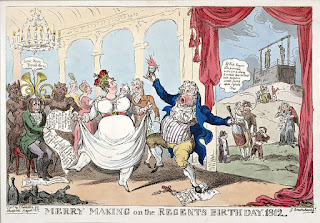The blog is for fun. My wandering thoughts. I like satire and positive thinking. My interests are in the Arts; theatre, literature, painting, sculpture. Erotica and fetish.
Friday, 12 October 2012
REGENCY OPULENCE
The Royal Pavilion, Brighton at night.
From 1811, George, later to become George IV, served as the Prince Regent for the last years of his father’s reign. George III had lapsed into mental illness and was considered unfit to govern the country. However, the Prince Regent had little to do with governing the country. The government was actually controlled by Lord Liverpool.
George, the Prince Regent, by Sir Thomas Lawrence.
The Napoleonic wars ended in 1815. England was overwhelmed with social and economic malaise, but you wouldn’t have known it, from the Prince Regent’s extravagant lifestyle. In fact George’s Regency saw an explosion of design, generating a mood of confidence, exuberance and expectation. As the Prince Regent, George was emperor of the world and he behaved accordingly. The many debacles of Prinny and his brothers prompted the Duke of Wellington to referred to George the III's sons as "The damnedest millstones about the neck of any Government that can be imagined."
The National Gallery, Trafalgar Square, London.
At 17 the Prince Regent had already begun a love-affair with a married actress and went on to marry, in secret, the infamous Mrs. Maria Fitzherbert.
The dining room in the Royal Pavilion.
The Royal Marriages Act of 1772 declared that King George III and the Privy Council needed to give their approval in order for the Prince to marry, this therefore rendered his secret marriage illegal.
Regency Dandies, by George Cruikshank
In dramatic contrast with his prosaic, scandal-free father, George threw himself with zest into a life of dissipation and wild extravagance involving heavy drinking and numerous mistresses and escapades. He was a witty conversationalist, drunk or sober, and showed good, but grossly expensive taste in decorating his palace. This was poor judgement, considering the poverty of many London residents. Large numbers of children and adults lived on the streets with no hope of shelter, freezing to death in winter or dying of starvation.
His lavish, extravagant lifestyle contributed to the opulent fashions of the British Regency. He was a patron of new forms of leisure, style, and taste. He commissioned John Nash to build the Royal Pavilion in Brighton and remodel Buckingham Palace, and Sir Jeffrey Wyatville to rebuild Windsor Castle. He was instrumental in the foundation of the National Gallery, London and King's College London.
As for the pavilion at Brighton, John Nash’s design embraced a new style; Orientalism. England was introduced to a new phenomenon in the arts; the shock of the new.
The Prince Regent’s life and times were satirised and parodied by the political cartoonist George Cruikshank. Cruikshank (27 September 1792 – 1 February 1878) was a British caricaturist and book illustrator, praised as the "modern Hogarth" during his lifetime. His book illustrations for his friend Charles Dickens, and many other authors, reached an international audience.
Subscribe to:
Post Comments (Atom)








General malaise is the only way to live!
ReplyDeleteYou are so right! I wish I could aim for opulence and a lavish lifestle, but my bank account won't permit it!
ReplyDeleteThen again, think of all of the things that we take for granted in our modern lifestyles that were totally unavailable even to the very rich of 200 years ago: the list is long and staggering. I wonder if "Prinny" wouldn't trade his pre-Victorian opulence for a middle-class lifestyle today? It's a totally unromantic perspective, I realize, but I still wonder...
Delete